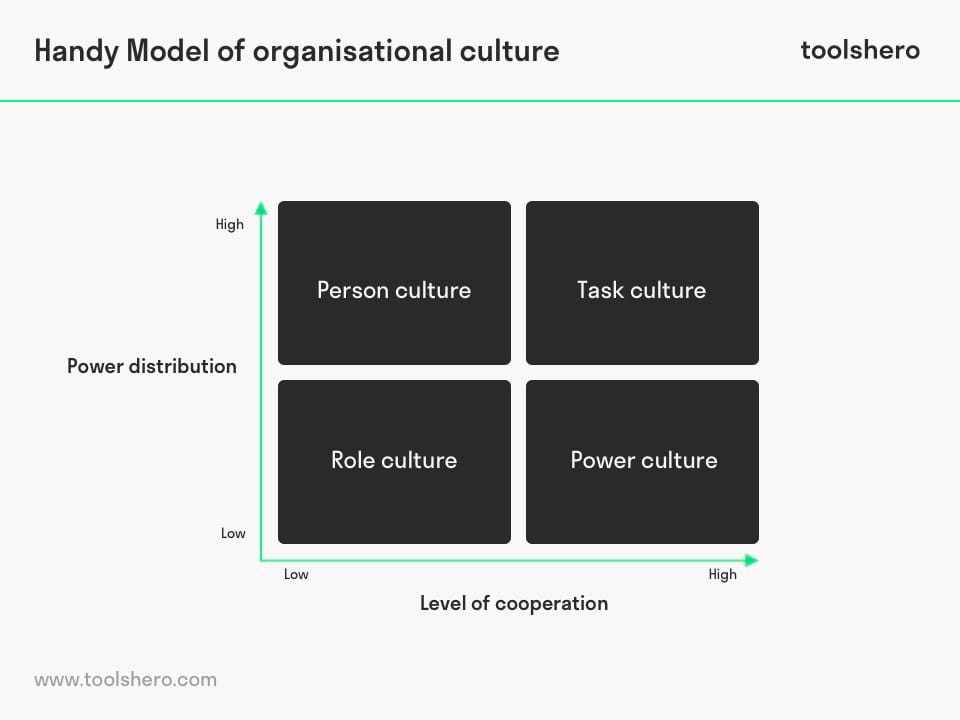Handy Model of Organisational Culture (Handy and Harrison)

Handy Model of Organisational Culture: this article describes the Handy Model of Organisational Culture of Organisational Culture, developed by Charles Handy and Roger Harrison in a practical way. After reading you will understand the definition and basics of this powerful management tool. Enjoy reading!
What is the Handy Model of Organisational Culture?
How is that in one company people are treated completely different than in another? American scientists Charles Handy and Roger Harrison researched this age-old question in the early seventies of the last century.
Professor of occupational psychology Roger Harrison and philosopher and expert on organisational behaviour Charles Handy designed a model which sets out four basic organisational types.
Handy Model of Organisational Culture: two dimensions
Based on two dimensions, Charles Handy and Roger Harrison followed various organisations and examined how power was distributed and the specific levels of cooperation. In a grid view, the power distribution from low to high is placed on the y-axis, and the level of cooperation from low to high is placed on the x-axis. The various combinations then result in four different organisational cultures.

Figure 1 – Handy model of organisational culture: two dimensions
Power distribution is all about the extent to which the top of an organisation (management or owner) is open to working with either a bottom-up or top-down approach.
In case of a bottom-up approach, the power distribution is very high; employees are expected to take their own responsibility, determine their tasks and make independent decisions.
In case of a complete top-down approach, there is hardly any power distribution; management or the owner is completely in control and is the only person making decisions.
The cooperation level, as the name suggests, is about the degree of cooperation between the various departments and employees. A lower cooperation level means everyone works for themselves and hardly requires the help of colleagues.
A high cooperation level, on the other hand, involves close, indispensable cooperation between colleagues. Ultimately, the combination of the two dimensions results in four organisational cultures: Role culture, Power Culture, Person Culture and Task Culture:
Role culture – Low degree of cooperation / Low power distribution
This type of culture is highly job-oriented and can often be found in bureaucratic organisations. It is also referred to as an Apollo culture, after the name of the Greek god of art and wisdom. In a role culture, employees want as much security and stability as possible.
The culture is known for its (strict) rules, obligations, agreements and procedures. There is a clear hierarchy and status is more important than performance. Due to this fact, a role culture is not always flexible.
Management of tasks takes place by means of procedures and clear job descriptions. This applies to both individual jobs as well as communication between departments. Key words within a role culture are safety, stability, conservatism and predictability.
Power culture – High cooperation levels / Low power distribution
This type of culture is characteristic of an entrepreneurial organisation; for example, small start-ups where the power lies with the founder and/or highest boss. Such organisations have a very flat structure and are led by a charismatic leader.
The entrepreneur has founded his company with much love and therefore finds it difficult to delegate decision-making. His employees have helped build the company and are very loyal to the organisation and each other.
Cooperation is extremely important in organisations with a power culture. Power culture is also referred to as Zeus culture, after the supreme god of ancient Greek. In a power culture, the highest power also lies with a top figure. Employees are loyal to the leader of the company. Due to the flat structure and start-up nature of the organisation, there are (still) few regulations and procedures.
As a result, the organisation is highly flexible. The relationship between employees is determined by the leader, but also by the means available to them (scarce goods). The founder attaches great importance to his power. He or she is a strong leader who controls the entire organisation.
He or she controls the organisation centrally, after which he determines who gets more power or to whom he delegates certain tasks. Individual performance and mutual collaboration are highly important.
Person culture – Low cooperation level / High power distribution
A person culture can often be found in professional organisations where employees have complete independence, are highly educated and can work with their own expertise. Think of law firms, health companies or academic research teams. A person culture is people-oriented and is also referred to as a Dionysus culture, after the Greek god of dance, pleasure, wine and immortality.
The organisation is entirely in service of the people who work there. It is all about the knowledge and expertise of the employees, who are preferably referred to as ‘members of the organisation’ instead. The number of employees in a person culture is generally small.
In a person culture, the individual is central. In these organisations, there are few rules and procedures. What links employees are departments and services they jointly use and depend on, such as the building they share, record keeping with reception, personnel management via HRM and a supporting service such as IT.
Their shared interests and values are also a binding element. Because it is often unclear who has final responsibility, there may occasionally be coordination problems within these types of organisations.
In general, a ‘pure’ person culture is very rare.
In most cases, a person culture will only be short-lived, and the organisation will gradually shift towards one of the other cultural typologies.
Task culture – High cooperation level / High power distribution
Many project or matrix organisations have a task culture, which is mainly result-oriented.
A task culture is also referred to as an Athena culture, who – like Apollo – is known for her wisdom.
In addition, she is also the goddess of martial arts and peace. Employees are experienced professionals and are problem-solving oriented.
They want to complete their tasks and /or projects correctly. Employees rely on both their own expertise and that of their colleagues.
Task culture organisations often deploy temporary teams, in which cooperation is paramount. The hierarchical power is not necessarily connected to a specific person, but is spread over the entire organisation.
Results are more important than rules, the balance of power or individual personal needs. Expertise and flexibility are central, and coordination depends on the task and/or project requirements. For example, a deadline or a high-quality end result.
Handy Model: Organisational culture versus organisational structure
According to Charles Handy and Roger Harrison, an organisational culture cannot be separated from other aspects of the organisation.
Especially the culture and structure and closely connected. There where a low power distribution can be found, there are clear hierarchical structures.
In case of more power distribution, horizontal (operational) and vertical (functional) leadership positions may arise. In addition, Charles Handy and Roger Harrison believe organisations should take into account conflicting interests between individuals’ and the organisation’s interests.
Especially in case of a low level of cooperation, it is sensible to make clear agreements about who is responsible for which tasks.
Both scientists also indicate that the aforementioned cultural typologies are ideal typefaces, which in reality rarely exist in pure form.
Instead, most organisations consist of a mixture of types.
It’s Your Turn
What do you think? What is your experience with the Handy Model of Organisational Culture? Do you recognize the practical explanation or do you have more additions? What are your success factors for managing organisational behaviour?
Share your experience and knowledge in the comments box below.
More information
- Handy, C. B. (2007). Understanding organizations. Penguin Uk.
- Handy, C. B. (1996). Gods of management: The changing work of organizations. Oxford University Press, USA.
- Ogbonna, E. (1992). Managing organisational culture: fantasy or reality?. Human Resource Management Journal, 3(2), 42-54.
How to cite this article:
Mulder, P. (2018). Handy Model of Organisational Culture (Handy and Harrison). Retrieved [insert date] from Toolshero: https://www.toolshero.com/management/handy-model/
Original publication date: 01/03/2018 | Last update: 11/26/2023
Add a link to this page on your website:
<a href=”https://www.toolshero.com/management/handy-model/”>Toolshero: Handy Model of Organisational Culture (Handy and Harrison)</a>












